Implement and Monitor WHS Policies, Procedures and Programs Report
VerifiedAdded on 2022/09/12
|24
|7442
|32
Report
AI Summary
This report delves into the critical aspects of implementing and monitoring Workplace Health and Safety (WHS) policies, procedures, and programs. It examines the obligations of managers and business owners, emphasizing their responsibilities in ensuring employee safety and well-being. The report covers key elements such as hazard identification, risk assessment, and control measures, providing a comprehensive understanding of these processes. It explores the purpose and application of codes of practice, including first aid in the workplace, and discusses the importance of employee training and communication. Through case studies and practical examples, the report illustrates how to identify and address workplace hazards, implement risk control procedures, and maintain a safe and healthy work environment. Furthermore, it highlights the significance of promptly implementing hazard reports, providing ongoing training, and maintaining injury registers to ensure continuous improvement in WHS practices. The report also addresses the purpose of the hierarchy of control and the importance of consulting with staff when implementing or reviewing WHS procedures.
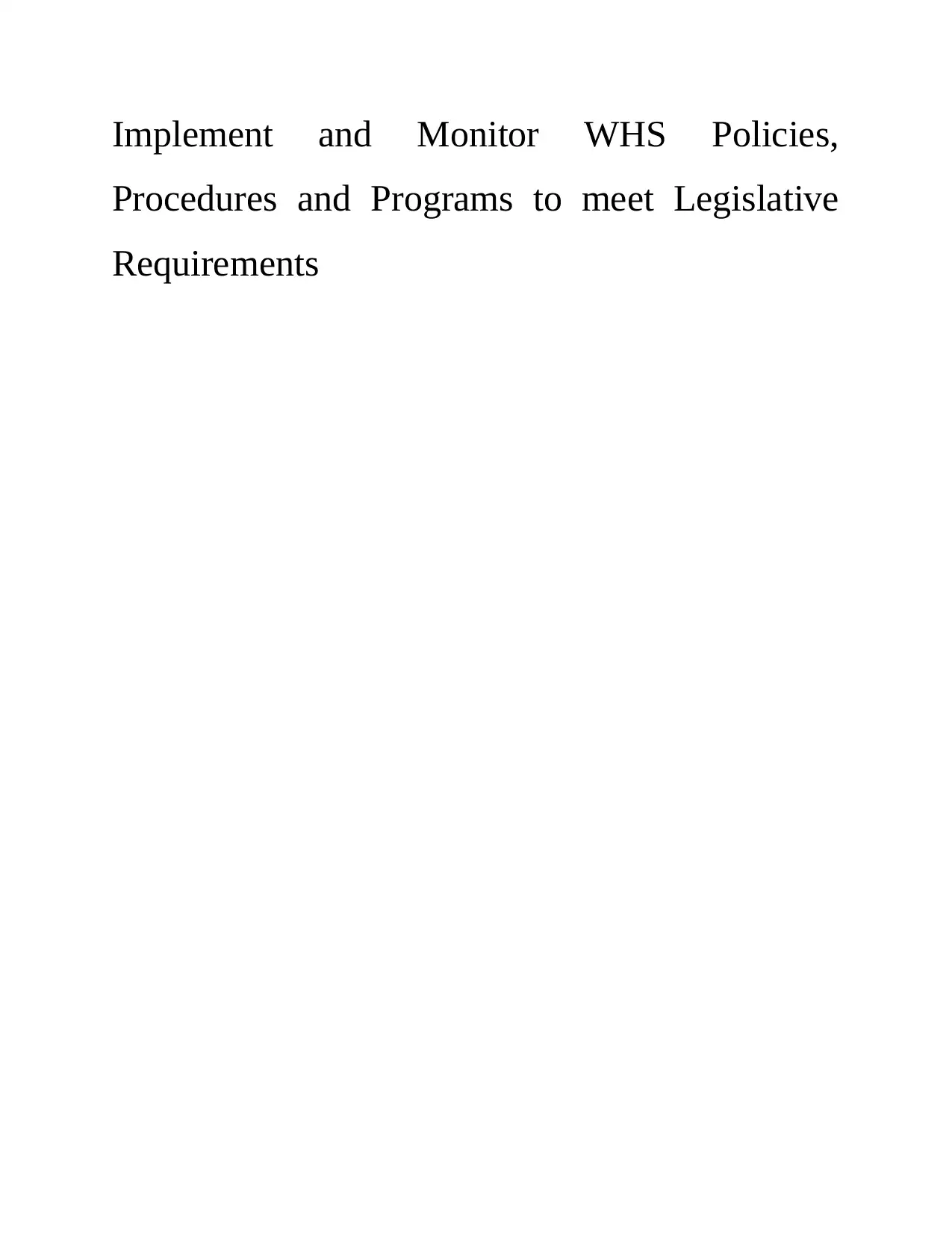
Implement and Monitor WHS Policies,
Procedures and Programs to meet Legislative
Requirements
Procedures and Programs to meet Legislative
Requirements
Paraphrase This Document
Need a fresh take? Get an instant paraphrase of this document with our AI Paraphraser
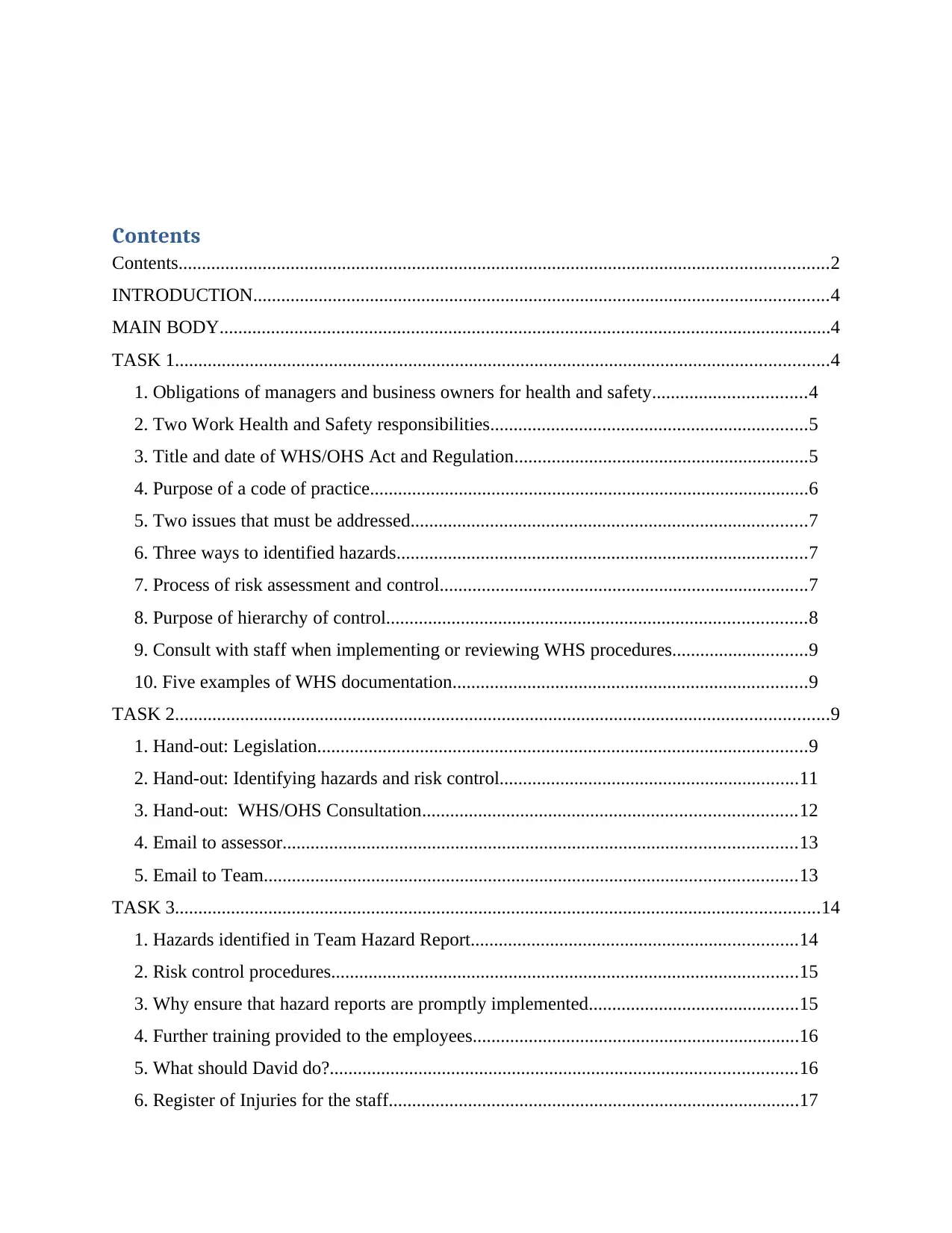
Contents
Contents...........................................................................................................................................2
INTRODUCTION...........................................................................................................................4
MAIN BODY...................................................................................................................................4
TASK 1............................................................................................................................................4
1. Obligations of managers and business owners for health and safety.................................4
2. Two Work Health and Safety responsibilities....................................................................5
3. Title and date of WHS/OHS Act and Regulation...............................................................5
4. Purpose of a code of practice..............................................................................................6
5. Two issues that must be addressed.....................................................................................7
6. Three ways to identified hazards........................................................................................7
7. Process of risk assessment and control...............................................................................7
8. Purpose of hierarchy of control..........................................................................................8
9. Consult with staff when implementing or reviewing WHS procedures.............................9
10. Five examples of WHS documentation............................................................................9
TASK 2............................................................................................................................................9
1. Hand-out: Legislation.........................................................................................................9
2. Hand-out: Identifying hazards and risk control................................................................11
3. Hand-out: WHS/OHS Consultation................................................................................12
4. Email to assessor..............................................................................................................13
5. Email to Team..................................................................................................................13
TASK 3..........................................................................................................................................14
1. Hazards identified in Team Hazard Report......................................................................14
2. Risk control procedures....................................................................................................15
3. Why ensure that hazard reports are promptly implemented.............................................15
4. Further training provided to the employees......................................................................16
5. What should David do?....................................................................................................16
6. Register of Injuries for the staff........................................................................................17
Contents...........................................................................................................................................2
INTRODUCTION...........................................................................................................................4
MAIN BODY...................................................................................................................................4
TASK 1............................................................................................................................................4
1. Obligations of managers and business owners for health and safety.................................4
2. Two Work Health and Safety responsibilities....................................................................5
3. Title and date of WHS/OHS Act and Regulation...............................................................5
4. Purpose of a code of practice..............................................................................................6
5. Two issues that must be addressed.....................................................................................7
6. Three ways to identified hazards........................................................................................7
7. Process of risk assessment and control...............................................................................7
8. Purpose of hierarchy of control..........................................................................................8
9. Consult with staff when implementing or reviewing WHS procedures.............................9
10. Five examples of WHS documentation............................................................................9
TASK 2............................................................................................................................................9
1. Hand-out: Legislation.........................................................................................................9
2. Hand-out: Identifying hazards and risk control................................................................11
3. Hand-out: WHS/OHS Consultation................................................................................12
4. Email to assessor..............................................................................................................13
5. Email to Team..................................................................................................................13
TASK 3..........................................................................................................................................14
1. Hazards identified in Team Hazard Report......................................................................14
2. Risk control procedures....................................................................................................15
3. Why ensure that hazard reports are promptly implemented.............................................15
4. Further training provided to the employees......................................................................16
5. What should David do?....................................................................................................16
6. Register of Injuries for the staff........................................................................................17
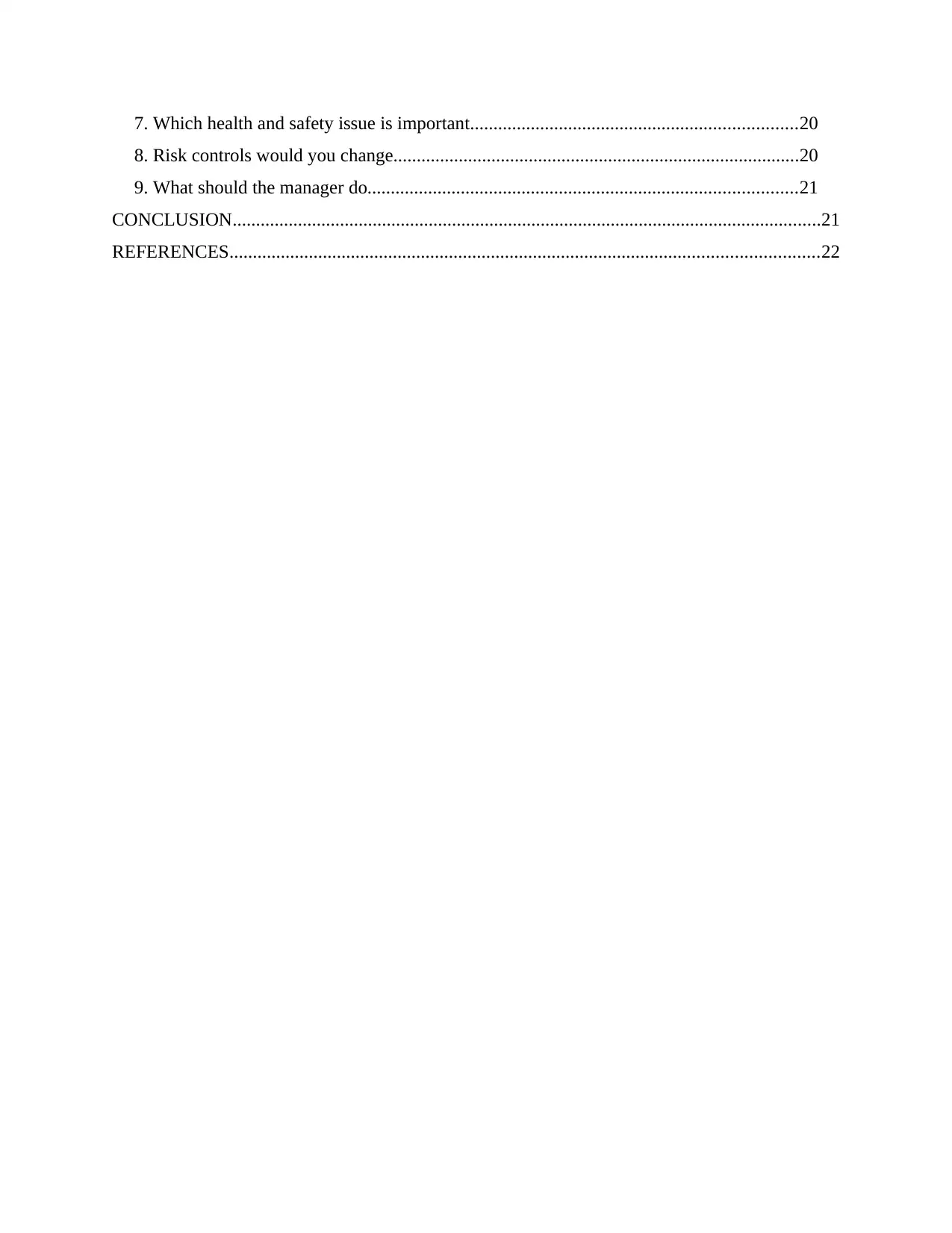
7. Which health and safety issue is important......................................................................20
8. Risk controls would you change.......................................................................................20
9. What should the manager do............................................................................................21
CONCLUSION..............................................................................................................................21
REFERENCES..............................................................................................................................22
8. Risk controls would you change.......................................................................................20
9. What should the manager do............................................................................................21
CONCLUSION..............................................................................................................................21
REFERENCES..............................................................................................................................22
⊘ This is a preview!⊘
Do you want full access?
Subscribe today to unlock all pages.

Trusted by 1+ million students worldwide
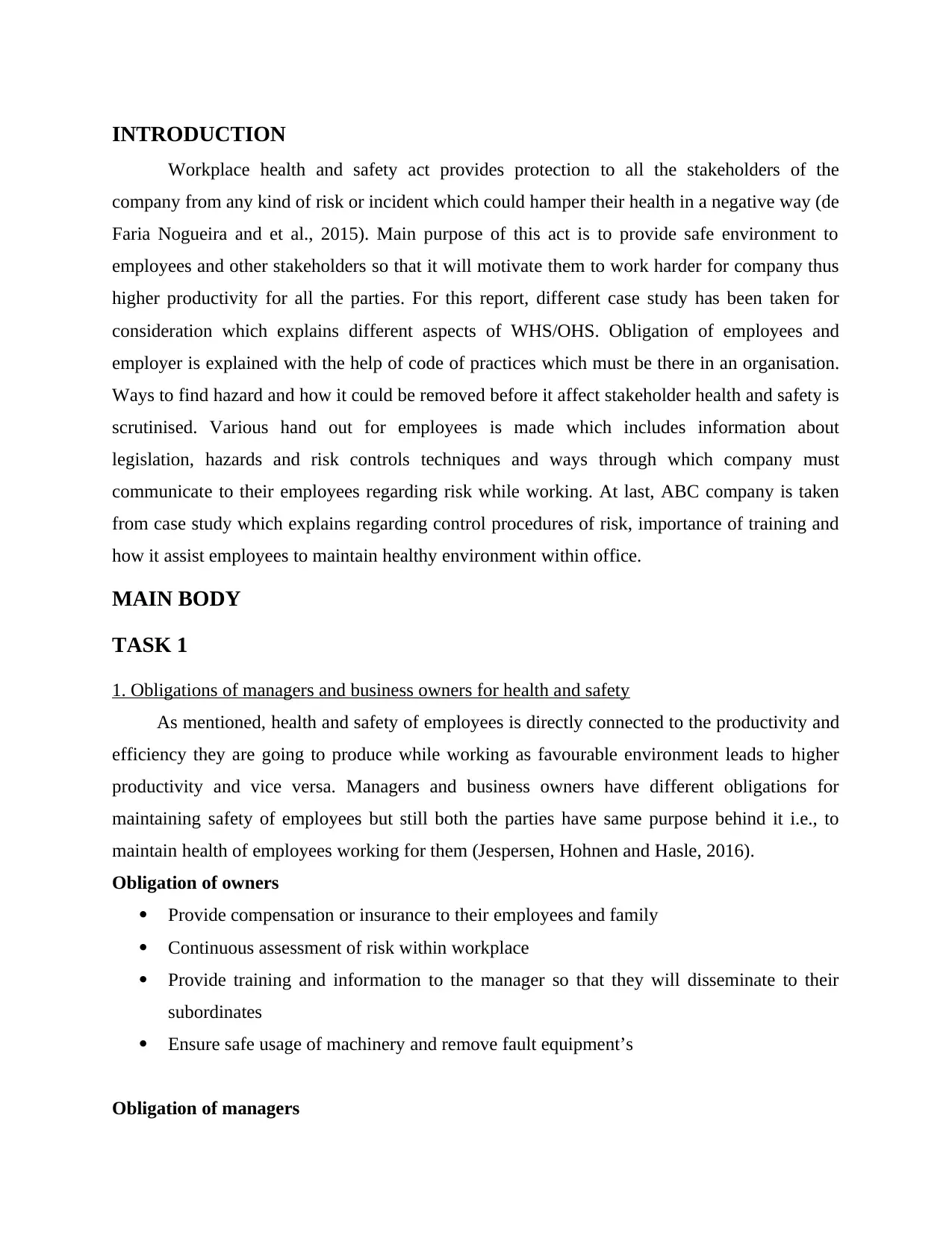
INTRODUCTION
Workplace health and safety act provides protection to all the stakeholders of the
company from any kind of risk or incident which could hamper their health in a negative way (de
Faria Nogueira and et al., 2015). Main purpose of this act is to provide safe environment to
employees and other stakeholders so that it will motivate them to work harder for company thus
higher productivity for all the parties. For this report, different case study has been taken for
consideration which explains different aspects of WHS/OHS. Obligation of employees and
employer is explained with the help of code of practices which must be there in an organisation.
Ways to find hazard and how it could be removed before it affect stakeholder health and safety is
scrutinised. Various hand out for employees is made which includes information about
legislation, hazards and risk controls techniques and ways through which company must
communicate to their employees regarding risk while working. At last, ABC company is taken
from case study which explains regarding control procedures of risk, importance of training and
how it assist employees to maintain healthy environment within office.
MAIN BODY
TASK 1
1. Obligations of managers and business owners for health and safety
As mentioned, health and safety of employees is directly connected to the productivity and
efficiency they are going to produce while working as favourable environment leads to higher
productivity and vice versa. Managers and business owners have different obligations for
maintaining safety of employees but still both the parties have same purpose behind it i.e., to
maintain health of employees working for them (Jespersen, Hohnen and Hasle, 2016).
Obligation of owners
Provide compensation or insurance to their employees and family
Continuous assessment of risk within workplace
Provide training and information to the manager so that they will disseminate to their
subordinates
Ensure safe usage of machinery and remove fault equipment’s
Obligation of managers
Workplace health and safety act provides protection to all the stakeholders of the
company from any kind of risk or incident which could hamper their health in a negative way (de
Faria Nogueira and et al., 2015). Main purpose of this act is to provide safe environment to
employees and other stakeholders so that it will motivate them to work harder for company thus
higher productivity for all the parties. For this report, different case study has been taken for
consideration which explains different aspects of WHS/OHS. Obligation of employees and
employer is explained with the help of code of practices which must be there in an organisation.
Ways to find hazard and how it could be removed before it affect stakeholder health and safety is
scrutinised. Various hand out for employees is made which includes information about
legislation, hazards and risk controls techniques and ways through which company must
communicate to their employees regarding risk while working. At last, ABC company is taken
from case study which explains regarding control procedures of risk, importance of training and
how it assist employees to maintain healthy environment within office.
MAIN BODY
TASK 1
1. Obligations of managers and business owners for health and safety
As mentioned, health and safety of employees is directly connected to the productivity and
efficiency they are going to produce while working as favourable environment leads to higher
productivity and vice versa. Managers and business owners have different obligations for
maintaining safety of employees but still both the parties have same purpose behind it i.e., to
maintain health of employees working for them (Jespersen, Hohnen and Hasle, 2016).
Obligation of owners
Provide compensation or insurance to their employees and family
Continuous assessment of risk within workplace
Provide training and information to the manager so that they will disseminate to their
subordinates
Ensure safe usage of machinery and remove fault equipment’s
Obligation of managers
Paraphrase This Document
Need a fresh take? Get an instant paraphrase of this document with our AI Paraphraser

Monitoring and managing employee’s activities at work while using machinery and
equipment’s
Continuous advice related to minimise of risk at workplace
Ensures that all the machinery used is according to the rules and regulations set by
authorities and owner
Conduct activities like mock drill or fire alarm drills for employees so that prepare them
for worst (Souza and Alves, 2018)
2. Two Work Health and Safety responsibilities
It is essential for every employee to follow instructions which is given by manager related to
usage of equipment’s as it might leads to accident if not properly handled (Maxwell and et al.,
2016). For instance, if employee does not know how to use fire hydrant at work then in
emergency situations would get worse for them. So to reduce these types of circumstances,
various responsibilities which employees have to fulfilled is given below,
Comply with all the instructions given by manager and written on equipment’s
Equipment’s must only be used when proper training is provided to them else avoid using it
To avoid any kind of risk and if identified then provide information to the managers so that
they can act accordingly
Not wilfully injure themselves or others by placing them at risk
Misuse of any equipment’s must not be happened while working
3. Title and date of WHS/OHS Act and Regulation
Work health and safety or occupational health and safety act deals in management of risk at
workplace and try to eradicate it at workplace so that stakeholder’s health would remain
favourable. It requires high amount of capital to implement WHS within workplace but it is one
of the factor which is essential for any business success (Dwyer and Hopwood, 2019). For
instance, if employees are not felling while working then highest productivity of them would not
be achieved thus low efficiency and low output by employees as compare to their competitors.
There are many benefits of WHS like it motivates staff to work harder thus higher productivity.
It reduces inures and illness at work which leads to low absenteeism of employees hence
improves staff efficiency. At last, it reduces staff insurance cost which in return increases
equipment’s
Continuous advice related to minimise of risk at workplace
Ensures that all the machinery used is according to the rules and regulations set by
authorities and owner
Conduct activities like mock drill or fire alarm drills for employees so that prepare them
for worst (Souza and Alves, 2018)
2. Two Work Health and Safety responsibilities
It is essential for every employee to follow instructions which is given by manager related to
usage of equipment’s as it might leads to accident if not properly handled (Maxwell and et al.,
2016). For instance, if employee does not know how to use fire hydrant at work then in
emergency situations would get worse for them. So to reduce these types of circumstances,
various responsibilities which employees have to fulfilled is given below,
Comply with all the instructions given by manager and written on equipment’s
Equipment’s must only be used when proper training is provided to them else avoid using it
To avoid any kind of risk and if identified then provide information to the managers so that
they can act accordingly
Not wilfully injure themselves or others by placing them at risk
Misuse of any equipment’s must not be happened while working
3. Title and date of WHS/OHS Act and Regulation
Work health and safety or occupational health and safety act deals in management of risk at
workplace and try to eradicate it at workplace so that stakeholder’s health would remain
favourable. It requires high amount of capital to implement WHS within workplace but it is one
of the factor which is essential for any business success (Dwyer and Hopwood, 2019). For
instance, if employees are not felling while working then highest productivity of them would not
be achieved thus low efficiency and low output by employees as compare to their competitors.
There are many benefits of WHS like it motivates staff to work harder thus higher productivity.
It reduces inures and illness at work which leads to low absenteeism of employees hence
improves staff efficiency. At last, it reduces staff insurance cost which in return increases
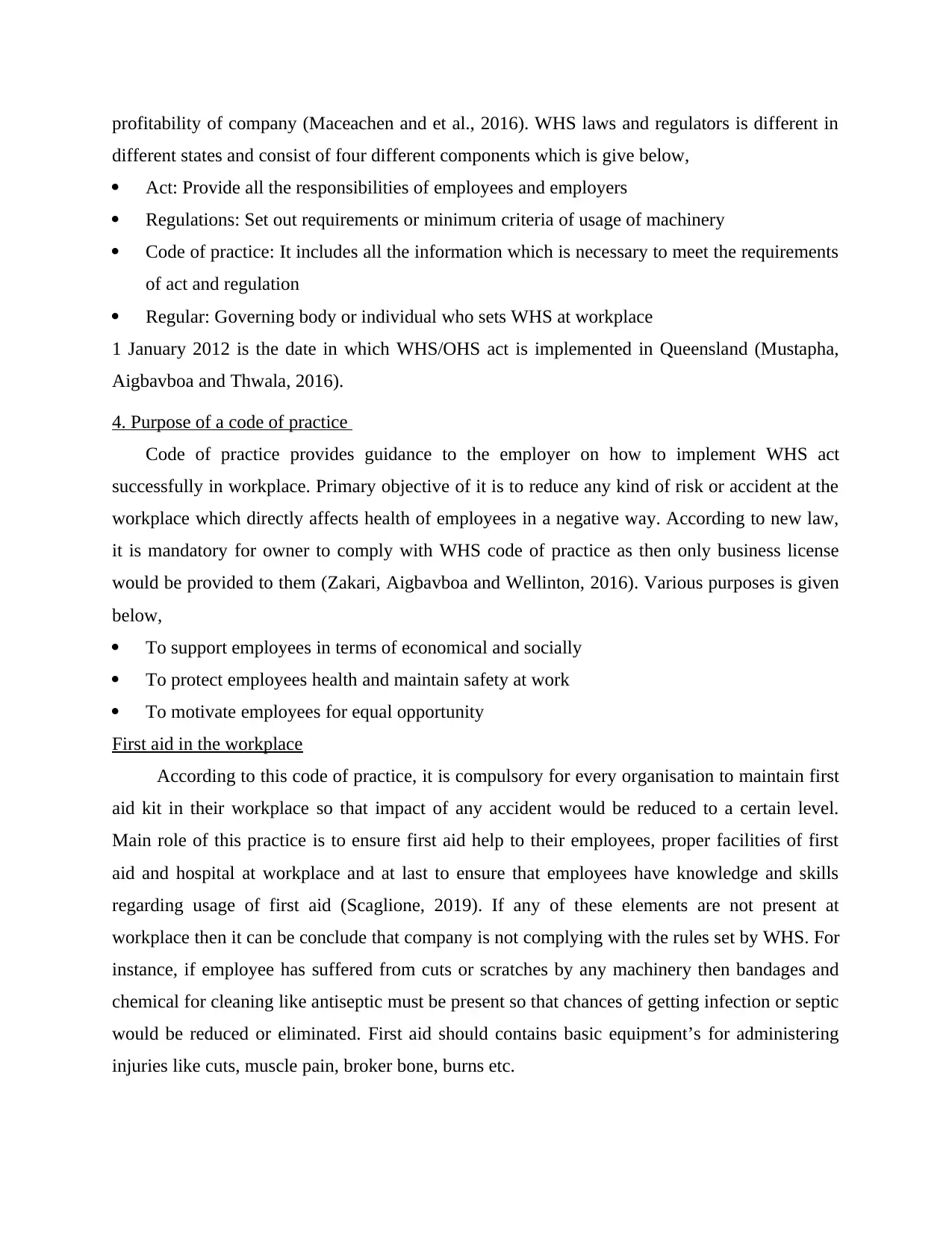
profitability of company (Maceachen and et al., 2016). WHS laws and regulators is different in
different states and consist of four different components which is give below,
Act: Provide all the responsibilities of employees and employers
Regulations: Set out requirements or minimum criteria of usage of machinery
Code of practice: It includes all the information which is necessary to meet the requirements
of act and regulation
Regular: Governing body or individual who sets WHS at workplace
1 January 2012 is the date in which WHS/OHS act is implemented in Queensland (Mustapha,
Aigbavboa and Thwala, 2016).
4. Purpose of a code of practice
Code of practice provides guidance to the employer on how to implement WHS act
successfully in workplace. Primary objective of it is to reduce any kind of risk or accident at the
workplace which directly affects health of employees in a negative way. According to new law,
it is mandatory for owner to comply with WHS code of practice as then only business license
would be provided to them (Zakari, Aigbavboa and Wellinton, 2016). Various purposes is given
below,
To support employees in terms of economical and socially
To protect employees health and maintain safety at work
To motivate employees for equal opportunity
First aid in the workplace
According to this code of practice, it is compulsory for every organisation to maintain first
aid kit in their workplace so that impact of any accident would be reduced to a certain level.
Main role of this practice is to ensure first aid help to their employees, proper facilities of first
aid and hospital at workplace and at last to ensure that employees have knowledge and skills
regarding usage of first aid (Scaglione, 2019). If any of these elements are not present at
workplace then it can be conclude that company is not complying with the rules set by WHS. For
instance, if employee has suffered from cuts or scratches by any machinery then bandages and
chemical for cleaning like antiseptic must be present so that chances of getting infection or septic
would be reduced or eliminated. First aid should contains basic equipment’s for administering
injuries like cuts, muscle pain, broker bone, burns etc.
different states and consist of four different components which is give below,
Act: Provide all the responsibilities of employees and employers
Regulations: Set out requirements or minimum criteria of usage of machinery
Code of practice: It includes all the information which is necessary to meet the requirements
of act and regulation
Regular: Governing body or individual who sets WHS at workplace
1 January 2012 is the date in which WHS/OHS act is implemented in Queensland (Mustapha,
Aigbavboa and Thwala, 2016).
4. Purpose of a code of practice
Code of practice provides guidance to the employer on how to implement WHS act
successfully in workplace. Primary objective of it is to reduce any kind of risk or accident at the
workplace which directly affects health of employees in a negative way. According to new law,
it is mandatory for owner to comply with WHS code of practice as then only business license
would be provided to them (Zakari, Aigbavboa and Wellinton, 2016). Various purposes is given
below,
To support employees in terms of economical and socially
To protect employees health and maintain safety at work
To motivate employees for equal opportunity
First aid in the workplace
According to this code of practice, it is compulsory for every organisation to maintain first
aid kit in their workplace so that impact of any accident would be reduced to a certain level.
Main role of this practice is to ensure first aid help to their employees, proper facilities of first
aid and hospital at workplace and at last to ensure that employees have knowledge and skills
regarding usage of first aid (Scaglione, 2019). If any of these elements are not present at
workplace then it can be conclude that company is not complying with the rules set by WHS. For
instance, if employee has suffered from cuts or scratches by any machinery then bandages and
chemical for cleaning like antiseptic must be present so that chances of getting infection or septic
would be reduced or eliminated. First aid should contains basic equipment’s for administering
injuries like cuts, muscle pain, broker bone, burns etc.
⊘ This is a preview!⊘
Do you want full access?
Subscribe today to unlock all pages.

Trusted by 1+ million students worldwide
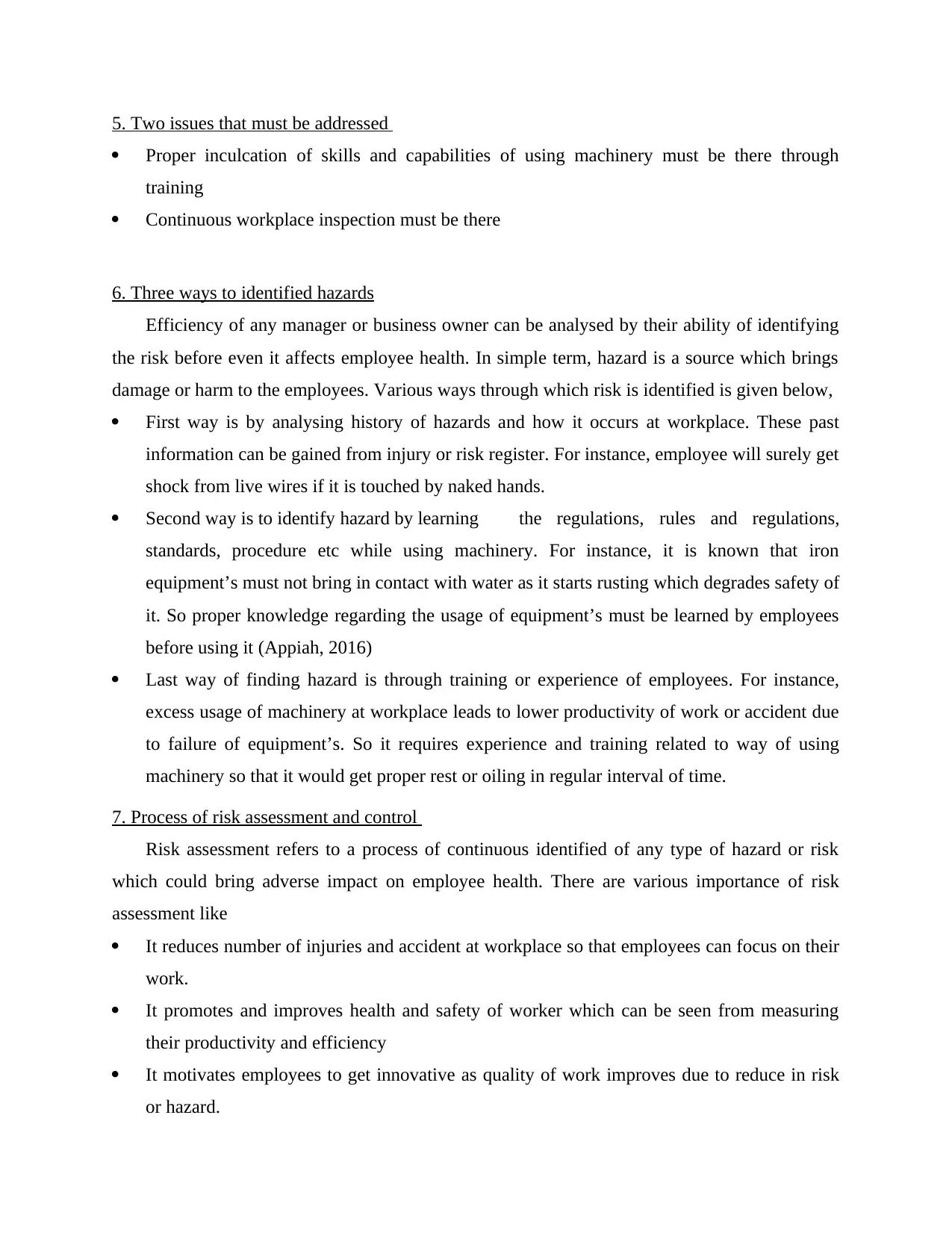
5. Two issues that must be addressed
Proper inculcation of skills and capabilities of using machinery must be there through
training
Continuous workplace inspection must be there
6. Three ways to identified hazards
Efficiency of any manager or business owner can be analysed by their ability of identifying
the risk before even it affects employee health. In simple term, hazard is a source which brings
damage or harm to the employees. Various ways through which risk is identified is given below,
First way is by analysing history of hazards and how it occurs at workplace. These past
information can be gained from injury or risk register. For instance, employee will surely get
shock from live wires if it is touched by naked hands.
Second way is to identify hazard by learning the regulations, rules and regulations,
standards, procedure etc while using machinery. For instance, it is known that iron
equipment’s must not bring in contact with water as it starts rusting which degrades safety of
it. So proper knowledge regarding the usage of equipment’s must be learned by employees
before using it (Appiah, 2016)
Last way of finding hazard is through training or experience of employees. For instance,
excess usage of machinery at workplace leads to lower productivity of work or accident due
to failure of equipment’s. So it requires experience and training related to way of using
machinery so that it would get proper rest or oiling in regular interval of time.
7. Process of risk assessment and control
Risk assessment refers to a process of continuous identified of any type of hazard or risk
which could bring adverse impact on employee health. There are various importance of risk
assessment like
It reduces number of injuries and accident at workplace so that employees can focus on their
work.
It promotes and improves health and safety of worker which can be seen from measuring
their productivity and efficiency
It motivates employees to get innovative as quality of work improves due to reduce in risk
or hazard.
Proper inculcation of skills and capabilities of using machinery must be there through
training
Continuous workplace inspection must be there
6. Three ways to identified hazards
Efficiency of any manager or business owner can be analysed by their ability of identifying
the risk before even it affects employee health. In simple term, hazard is a source which brings
damage or harm to the employees. Various ways through which risk is identified is given below,
First way is by analysing history of hazards and how it occurs at workplace. These past
information can be gained from injury or risk register. For instance, employee will surely get
shock from live wires if it is touched by naked hands.
Second way is to identify hazard by learning the regulations, rules and regulations,
standards, procedure etc while using machinery. For instance, it is known that iron
equipment’s must not bring in contact with water as it starts rusting which degrades safety of
it. So proper knowledge regarding the usage of equipment’s must be learned by employees
before using it (Appiah, 2016)
Last way of finding hazard is through training or experience of employees. For instance,
excess usage of machinery at workplace leads to lower productivity of work or accident due
to failure of equipment’s. So it requires experience and training related to way of using
machinery so that it would get proper rest or oiling in regular interval of time.
7. Process of risk assessment and control
Risk assessment refers to a process of continuous identified of any type of hazard or risk
which could bring adverse impact on employee health. There are various importance of risk
assessment like
It reduces number of injuries and accident at workplace so that employees can focus on their
work.
It promotes and improves health and safety of worker which can be seen from measuring
their productivity and efficiency
It motivates employees to get innovative as quality of work improves due to reduce in risk
or hazard.
Paraphrase This Document
Need a fresh take? Get an instant paraphrase of this document with our AI Paraphraser
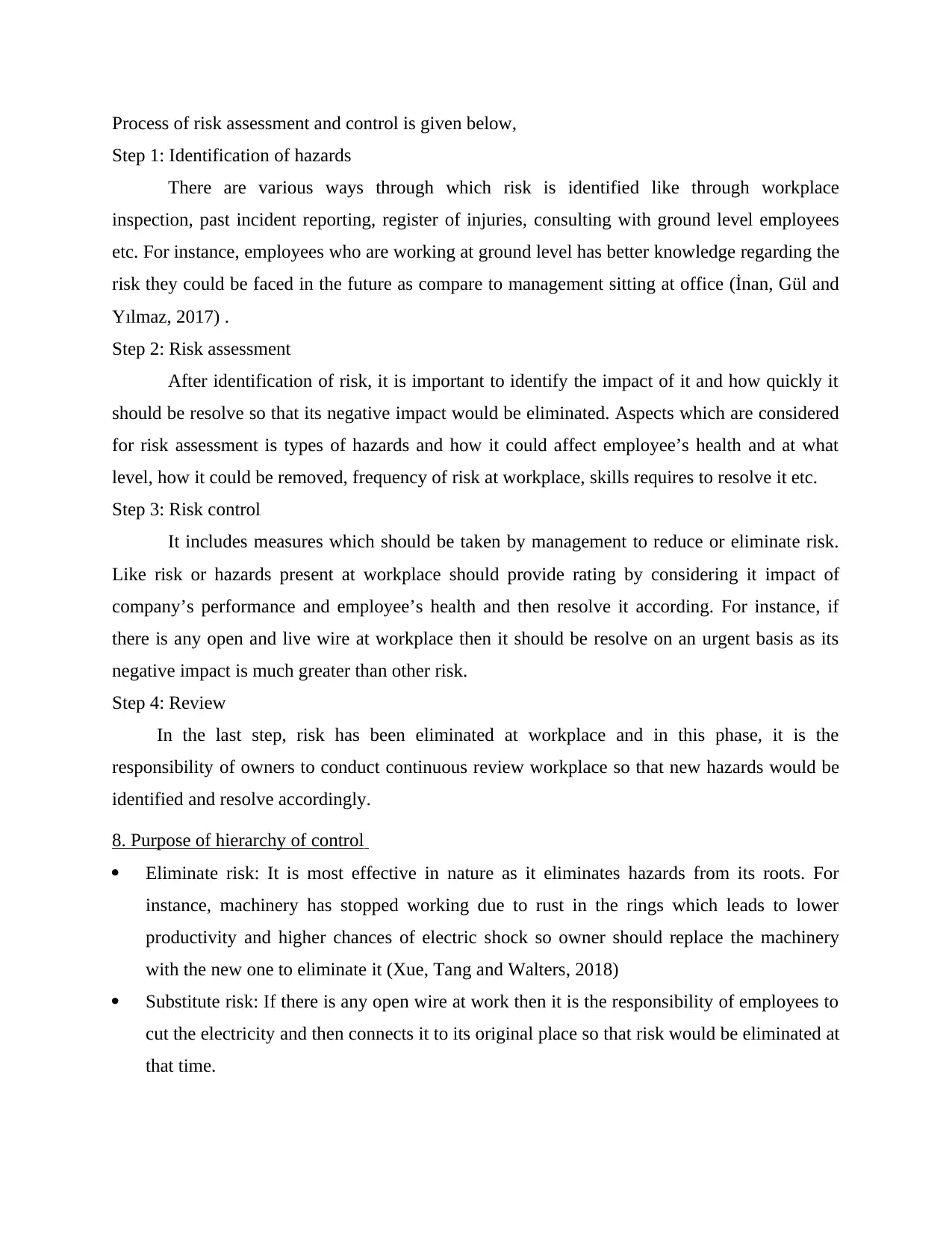
Process of risk assessment and control is given below,
Step 1: Identification of hazards
There are various ways through which risk is identified like through workplace
inspection, past incident reporting, register of injuries, consulting with ground level employees
etc. For instance, employees who are working at ground level has better knowledge regarding the
risk they could be faced in the future as compare to management sitting at office (İnan, Gül and
Yılmaz, 2017) .
Step 2: Risk assessment
After identification of risk, it is important to identify the impact of it and how quickly it
should be resolve so that its negative impact would be eliminated. Aspects which are considered
for risk assessment is types of hazards and how it could affect employee’s health and at what
level, how it could be removed, frequency of risk at workplace, skills requires to resolve it etc.
Step 3: Risk control
It includes measures which should be taken by management to reduce or eliminate risk.
Like risk or hazards present at workplace should provide rating by considering it impact of
company’s performance and employee’s health and then resolve it according. For instance, if
there is any open and live wire at workplace then it should be resolve on an urgent basis as its
negative impact is much greater than other risk.
Step 4: Review
In the last step, risk has been eliminated at workplace and in this phase, it is the
responsibility of owners to conduct continuous review workplace so that new hazards would be
identified and resolve accordingly.
8. Purpose of hierarchy of control
Eliminate risk: It is most effective in nature as it eliminates hazards from its roots. For
instance, machinery has stopped working due to rust in the rings which leads to lower
productivity and higher chances of electric shock so owner should replace the machinery
with the new one to eliminate it (Xue, Tang and Walters, 2018)
Substitute risk: If there is any open wire at work then it is the responsibility of employees to
cut the electricity and then connects it to its original place so that risk would be eliminated at
that time.
Step 1: Identification of hazards
There are various ways through which risk is identified like through workplace
inspection, past incident reporting, register of injuries, consulting with ground level employees
etc. For instance, employees who are working at ground level has better knowledge regarding the
risk they could be faced in the future as compare to management sitting at office (İnan, Gül and
Yılmaz, 2017) .
Step 2: Risk assessment
After identification of risk, it is important to identify the impact of it and how quickly it
should be resolve so that its negative impact would be eliminated. Aspects which are considered
for risk assessment is types of hazards and how it could affect employee’s health and at what
level, how it could be removed, frequency of risk at workplace, skills requires to resolve it etc.
Step 3: Risk control
It includes measures which should be taken by management to reduce or eliminate risk.
Like risk or hazards present at workplace should provide rating by considering it impact of
company’s performance and employee’s health and then resolve it according. For instance, if
there is any open and live wire at workplace then it should be resolve on an urgent basis as its
negative impact is much greater than other risk.
Step 4: Review
In the last step, risk has been eliminated at workplace and in this phase, it is the
responsibility of owners to conduct continuous review workplace so that new hazards would be
identified and resolve accordingly.
8. Purpose of hierarchy of control
Eliminate risk: It is most effective in nature as it eliminates hazards from its roots. For
instance, machinery has stopped working due to rust in the rings which leads to lower
productivity and higher chances of electric shock so owner should replace the machinery
with the new one to eliminate it (Xue, Tang and Walters, 2018)
Substitute risk: If there is any open wire at work then it is the responsibility of employees to
cut the electricity and then connects it to its original place so that risk would be eliminated at
that time.

Minimise risk: It means using of equipment’s or guards to avoid risk. It is mandatory to
wear plastic gloves while touching the live wire as electricity impact is null in rubber gloves.
9. Consult with staff when implementing or reviewing WHS procedures
It is essential for owner to consult with employees while setting WHS because of following
reason,
Employees work on ground level has experience of using machinery and has knowledge
regarding hazards they could face in the future if not properly resolve in the first place
Discussing issues and polices with employee’s increases their trust towards company which
leads to higher overall efficiency.
Employees get motivated if they are aware about the job they are doing and how they could
improve their productivity with the assistance of management thus higher job satisfaction
10. Five examples of WHS documentation
Manual task procedure
Risk management procedure
Safety talks guidelines
Monitoring and management procedure
Manager WHS induction
TASK 2
1. Hand-out: Legislation
Work Health and Safety (WHS)/Occupational Health and Safety (OHS) for OfficePro
Purpose: The purpose of this act is to safeguard the health and safety of staff and workplace by
minimizing or completely eliminating risk and hazardous situations. These can be done by
effective representation of information, cooperation from team members and by adopting
updated issue resolution techniques (Ross, Penesis and Badrick, 2019). This act also justifies that
staff and other workers should get maximum level of safety and security as it is the basic
principle of the act.
Functions:
Imposing health and safety duties.
Compiling reasonable practicable duties.
wear plastic gloves while touching the live wire as electricity impact is null in rubber gloves.
9. Consult with staff when implementing or reviewing WHS procedures
It is essential for owner to consult with employees while setting WHS because of following
reason,
Employees work on ground level has experience of using machinery and has knowledge
regarding hazards they could face in the future if not properly resolve in the first place
Discussing issues and polices with employee’s increases their trust towards company which
leads to higher overall efficiency.
Employees get motivated if they are aware about the job they are doing and how they could
improve their productivity with the assistance of management thus higher job satisfaction
10. Five examples of WHS documentation
Manual task procedure
Risk management procedure
Safety talks guidelines
Monitoring and management procedure
Manager WHS induction
TASK 2
1. Hand-out: Legislation
Work Health and Safety (WHS)/Occupational Health and Safety (OHS) for OfficePro
Purpose: The purpose of this act is to safeguard the health and safety of staff and workplace by
minimizing or completely eliminating risk and hazardous situations. These can be done by
effective representation of information, cooperation from team members and by adopting
updated issue resolution techniques (Ross, Penesis and Badrick, 2019). This act also justifies that
staff and other workers should get maximum level of safety and security as it is the basic
principle of the act.
Functions:
Imposing health and safety duties.
Compiling reasonable practicable duties.
⊘ This is a preview!⊘
Do you want full access?
Subscribe today to unlock all pages.

Trusted by 1+ million students worldwide
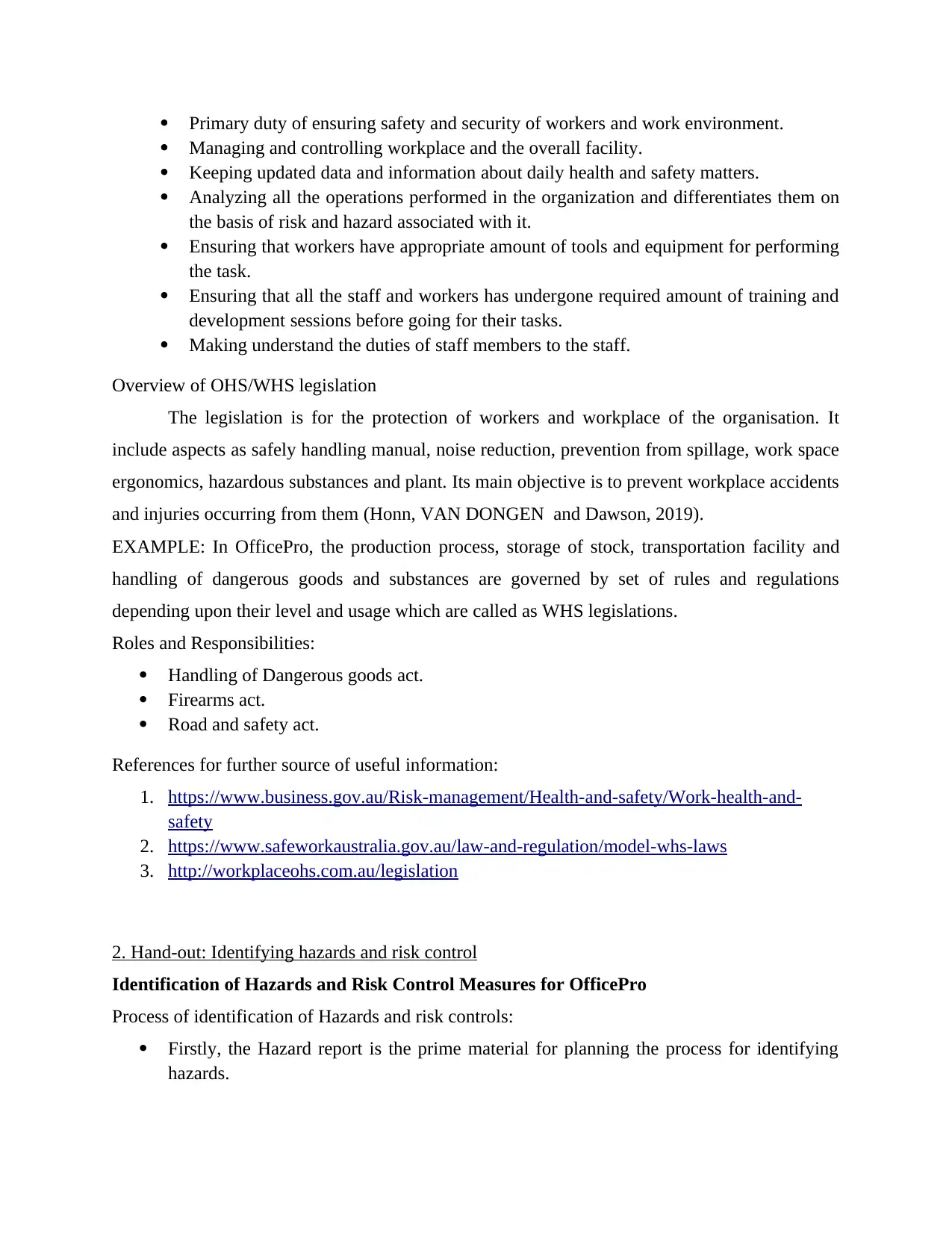
Primary duty of ensuring safety and security of workers and work environment.
Managing and controlling workplace and the overall facility.
Keeping updated data and information about daily health and safety matters.
Analyzing all the operations performed in the organization and differentiates them on
the basis of risk and hazard associated with it.
Ensuring that workers have appropriate amount of tools and equipment for performing
the task.
Ensuring that all the staff and workers has undergone required amount of training and
development sessions before going for their tasks.
Making understand the duties of staff members to the staff.
Overview of OHS/WHS legislation
The legislation is for the protection of workers and workplace of the organisation. It
include aspects as safely handling manual, noise reduction, prevention from spillage, work space
ergonomics, hazardous substances and plant. Its main objective is to prevent workplace accidents
and injuries occurring from them (Honn, VAN DONGEN and Dawson, 2019).
EXAMPLE: In OfficePro, the production process, storage of stock, transportation facility and
handling of dangerous goods and substances are governed by set of rules and regulations
depending upon their level and usage which are called as WHS legislations.
Roles and Responsibilities:
Handling of Dangerous goods act.
Firearms act.
Road and safety act.
References for further source of useful information:
1. https://www.business.gov.au/Risk-management/Health-and-safety/Work-health-and-
safety
2. https://www.safeworkaustralia.gov.au/law-and-regulation/model-whs-laws
3. http://workplaceohs.com.au/legislation
2. Hand-out: Identifying hazards and risk control
Identification of Hazards and Risk Control Measures for OfficePro
Process of identification of Hazards and risk controls:
Firstly, the Hazard report is the prime material for planning the process for identifying
hazards.
Managing and controlling workplace and the overall facility.
Keeping updated data and information about daily health and safety matters.
Analyzing all the operations performed in the organization and differentiates them on
the basis of risk and hazard associated with it.
Ensuring that workers have appropriate amount of tools and equipment for performing
the task.
Ensuring that all the staff and workers has undergone required amount of training and
development sessions before going for their tasks.
Making understand the duties of staff members to the staff.
Overview of OHS/WHS legislation
The legislation is for the protection of workers and workplace of the organisation. It
include aspects as safely handling manual, noise reduction, prevention from spillage, work space
ergonomics, hazardous substances and plant. Its main objective is to prevent workplace accidents
and injuries occurring from them (Honn, VAN DONGEN and Dawson, 2019).
EXAMPLE: In OfficePro, the production process, storage of stock, transportation facility and
handling of dangerous goods and substances are governed by set of rules and regulations
depending upon their level and usage which are called as WHS legislations.
Roles and Responsibilities:
Handling of Dangerous goods act.
Firearms act.
Road and safety act.
References for further source of useful information:
1. https://www.business.gov.au/Risk-management/Health-and-safety/Work-health-and-
safety
2. https://www.safeworkaustralia.gov.au/law-and-regulation/model-whs-laws
3. http://workplaceohs.com.au/legislation
2. Hand-out: Identifying hazards and risk control
Identification of Hazards and Risk Control Measures for OfficePro
Process of identification of Hazards and risk controls:
Firstly, the Hazard report is the prime material for planning the process for identifying
hazards.
Paraphrase This Document
Need a fresh take? Get an instant paraphrase of this document with our AI Paraphraser

Secondly, hazards can be identified by regularly inspecting the work place area and
taking reviews regularly from workers.
Thirdly, hazards are also the events of health and safety, therefore regular medical facility
should be provided in the work place area.
Common examples of Hazards and their controls that may occur in OfficePro:
1) Dripping of water from air conditioning and the control measure for this hazard is
substitution of the old air conditioning with the new one.
2) Piling up of clutter due to audit and causing disturbance in work place ergonomics.
3) Staff should keep equipment for handling manually heavy objects or they will seriously
injure themselves.
4) Not updating daily routine check list for the clearance of hygiene in the work space area
which will lead to health issues in the staff and it can be eliminated by regularly checking the
hygiene of the works area.
5) Spillage of hazardous substance can cause serious damage to the work space of the
organisation and also the people working in it, this risk can be controlled by providing
learning and development sessions about handling hazardous substances in work place will
benefit in decreasing such events.
Step by step procedure for dealing with Hazard of dripping of water from air conditioning:
The hierarchy of control states that there is a list of situations which are ranked from most
effective to least effective situations and their risk control measure:
I. Elimination – This procedure involves physically removing the hazard.
II. Substitution – According to this procedure the replacement of the hazard is done
by the management.
III. Engineering controls – This procedure involves in isolating the people from the
hazard.
IV. Administrative controls – This procedure change the way people work at their
work place.
taking reviews regularly from workers.
Thirdly, hazards are also the events of health and safety, therefore regular medical facility
should be provided in the work place area.
Common examples of Hazards and their controls that may occur in OfficePro:
1) Dripping of water from air conditioning and the control measure for this hazard is
substitution of the old air conditioning with the new one.
2) Piling up of clutter due to audit and causing disturbance in work place ergonomics.
3) Staff should keep equipment for handling manually heavy objects or they will seriously
injure themselves.
4) Not updating daily routine check list for the clearance of hygiene in the work space area
which will lead to health issues in the staff and it can be eliminated by regularly checking the
hygiene of the works area.
5) Spillage of hazardous substance can cause serious damage to the work space of the
organisation and also the people working in it, this risk can be controlled by providing
learning and development sessions about handling hazardous substances in work place will
benefit in decreasing such events.
Step by step procedure for dealing with Hazard of dripping of water from air conditioning:
The hierarchy of control states that there is a list of situations which are ranked from most
effective to least effective situations and their risk control measure:
I. Elimination – This procedure involves physically removing the hazard.
II. Substitution – According to this procedure the replacement of the hazard is done
by the management.
III. Engineering controls – This procedure involves in isolating the people from the
hazard.
IV. Administrative controls – This procedure change the way people work at their
work place.

Personal protective equipment – This procedure protect the staff by providing them with
effective tools and equipment.
3. Hand-out: WHS/OHS Consultation
Requirements for OHS/WHS consultation under legislation in OfficePro
OHS/WHS consultation under legislation is a legal requirement and an important part of
managing and controlling risk in the organisation’s health and safety (Sekendiz and et al., 2018).
A safe work place is only achieved when there is a clear communication between the staff and
workers about the procedures undertaken to reduce risk at work place area.
The requirement of greater awareness and commitment from the employees of the
organization.
To maintain positive working relationship among the workers and staff members because
this leads to build trust and cooperation.
To increase knowledge and understanding of activities of each person in the situation of
hazard and risk.
Dependency on others, it is very common in many organizations and because of which
OHS/WHS are very useful. Duty holders assumes that their subordinates will take care of
their duties but sometimes they are wrong because subordinates do not have proper
knowledge about controlling of hazardous or risk situation.
Importance of WHS/OHS consultation in OfficePro:
For the identification of hazards, analyzing risk and making appropriate decisions to
minimize or eliminate those risks.
It also helps in taking decisions for the improvement of work place ergonomics.
The proper implementation of changes related to health and safety of workers and work
place in the organization (Sutton, 2017).
To reduce the hazardous events and controlling risk associated with them, which ultimately
benefit organisation by increasing their production and profits.
4. Email to assessor
To,
Assessor
Subject – Regarding Health and Safety measures and feedback on attached Hand-Outs
Respected Assessor,
The purpose of this email is to introduce to you with a project and seeking for its approval for
moving forward. The attached hand-outs are about maintaining health and safety in the OfficePro
effective tools and equipment.
3. Hand-out: WHS/OHS Consultation
Requirements for OHS/WHS consultation under legislation in OfficePro
OHS/WHS consultation under legislation is a legal requirement and an important part of
managing and controlling risk in the organisation’s health and safety (Sekendiz and et al., 2018).
A safe work place is only achieved when there is a clear communication between the staff and
workers about the procedures undertaken to reduce risk at work place area.
The requirement of greater awareness and commitment from the employees of the
organization.
To maintain positive working relationship among the workers and staff members because
this leads to build trust and cooperation.
To increase knowledge and understanding of activities of each person in the situation of
hazard and risk.
Dependency on others, it is very common in many organizations and because of which
OHS/WHS are very useful. Duty holders assumes that their subordinates will take care of
their duties but sometimes they are wrong because subordinates do not have proper
knowledge about controlling of hazardous or risk situation.
Importance of WHS/OHS consultation in OfficePro:
For the identification of hazards, analyzing risk and making appropriate decisions to
minimize or eliminate those risks.
It also helps in taking decisions for the improvement of work place ergonomics.
The proper implementation of changes related to health and safety of workers and work
place in the organization (Sutton, 2017).
To reduce the hazardous events and controlling risk associated with them, which ultimately
benefit organisation by increasing their production and profits.
4. Email to assessor
To,
Assessor
Subject – Regarding Health and Safety measures and feedback on attached Hand-Outs
Respected Assessor,
The purpose of this email is to introduce to you with a project and seeking for its approval for
moving forward. The attached hand-outs are about maintaining health and safety in the OfficePro
⊘ This is a preview!⊘
Do you want full access?
Subscribe today to unlock all pages.

Trusted by 1+ million students worldwide
1 out of 24
Related Documents
Your All-in-One AI-Powered Toolkit for Academic Success.
+13062052269
info@desklib.com
Available 24*7 on WhatsApp / Email
![[object Object]](/_next/static/media/star-bottom.7253800d.svg)
Unlock your academic potential
Copyright © 2020–2025 A2Z Services. All Rights Reserved. Developed and managed by ZUCOL.




